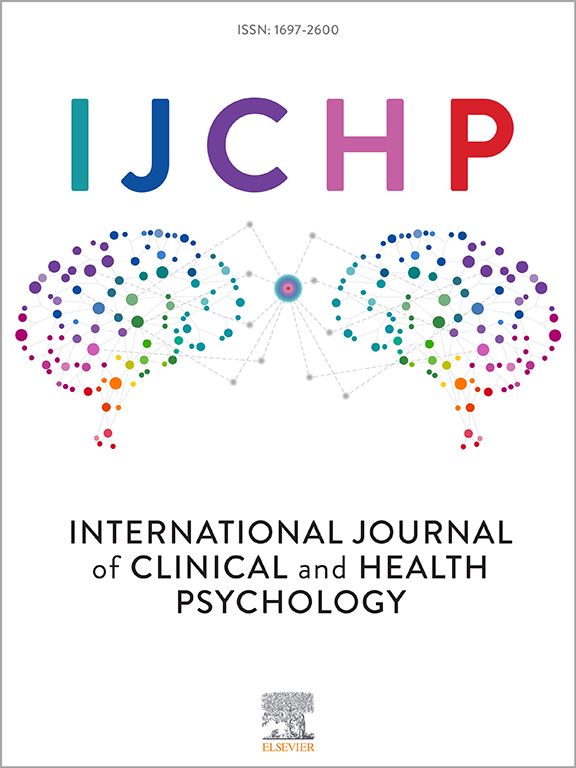Exploring dropout in internet-delivered cognitive behavioral therapy for insomnia: A secondary analysis of prevalence, self-reported reasons, and baseline and intervention data as predictors
IF 5.3
1区 心理学
Q1 PSYCHOLOGY, CLINICAL
International Journal of Clinical and Health Psychology
Pub Date : 2025-06-28
DOI:10.1016/j.ijchp.2025.100598
引用次数: 0
Abstract
Introduction
Internet-delivered cognitive behavioral therapy for insomnia (iCBT-I) is an effective treatment. However, dropout is a common challenge in digital therapeutics. This study examines dropout in iCBT-I by analyzing reported reasons for dropout and investigating whether baseline variables and intervention usage data can predict dropout.
Methods
This is an exploratory secondary analysis of a clinical trial investigating a stepped care model for insomnia featuring an eight-module iCBT-I. Reasons for dropout from the iCBT-I were assessed via self-developed items in follow-up surveys, and a dropout survey was sent to all patients who had not completed at least seven modules of the iCBT-I within 12 weeks. The proportion of respondents who agreed with the respective items was calculated. Additionally, bivariate models were specified to explore whether baseline variables and intervention usage data can predict dropout.
Results
The patients included in this sub-study had a mean age of 49.3 (SD=13.0), with 73.4 % identifying as female. At pre-treatment, their mean insomnia severity was 18.6 (SD=3.9). Among the 233 patients, 103 (44.2 %) were categorized as dropouts. The most frequently reported reasons for dropout were distractions from daily life, the perception of the content not being useful, and difficulties resuming after a break. None of the examined baseline variables significantly predicted dropout, whereas the time needed to complete the first module (OR=1.16; 95 %CI=1.08–1.27) and the number of sleep diary entries in the first week (OR=0.73; 95 %CI=0.65–0.80) significantly predicted dropout.
Discussion
This study highlights dropout as a relevant challenge in iCBT-I, affecting over 40 % of patients. Self-reported reasons indicate the importance of compatibility with distractions from daily life and perceived effectiveness. The prediction models suggest that dropout risk profiles can be developed based on first-week treatment data. Future research should focus on validating such models to improve effectiveness and user retention.
探索互联网提供的失眠症认知行为疗法中的辍学率:对患病率、自我报告的原因、基线和干预数据作为预测因素的二次分析
互联网认知行为疗法(iCBT-I)是一种有效的失眠治疗方法。然而,辍学是数字治疗中常见的挑战。本研究通过分析报告的辍学原因和调查基线变量和干预使用数据是否可以预测辍学来检查iCBT-I的辍学。方法:本研究是对一项临床试验的探索性二次分析,该试验研究了以8模块iCBT-I为特征的失眠阶梯式护理模型。通过随访调查中自行开发的项目评估退出iCBT-I的原因,并向所有在12周内未完成至少7个iCBT-I模块的患者发送退出调查。计算了同意各项目的受访者的比例。此外,我们指定了双变量模型来探讨基线变量和干预使用数据是否可以预测辍学。结果纳入的患者平均年龄为49.3岁(SD=13.0),其中73.4%为女性。在治疗前,他们的平均失眠严重程度为18.6 (SD=3.9)。在233例患者中,103例(44.2%)被归类为退出。报告中最常见的辍学原因是日常生活中的分心,认为内容没有用,以及休息后难以恢复。检查的基线变量中没有一个显着预测辍学,而完成第一个模块所需的时间(OR=1.16;95% CI= 1.08-1.27)和第一周睡眠日记条目数(OR=0.73;95% CI= 0.65-0.80)显著预测辍学率。本研究强调,退出是iCBT-I的一个相关挑战,影响了超过40%的患者。自我报告的原因表明,与日常生活中的干扰和感知有效性相适应的重要性。预测模型表明,可以根据第一周的治疗数据制定辍学风险概况。未来的研究应侧重于验证这些模型,以提高有效性和用户留存率。
本文章由计算机程序翻译,如有差异,请以英文原文为准。
求助全文
约1分钟内获得全文
求助全文
来源期刊

International Journal of Clinical and Health Psychology
PSYCHOLOGY, CLINICAL-
CiteScore
10.70
自引率
5.70%
发文量
38
审稿时长
33 days
期刊介绍:
The International Journal of Clinical and Health Psychology is dedicated to publishing manuscripts with a strong emphasis on both basic and applied research, encompassing experimental, clinical, and theoretical contributions that advance the fields of Clinical and Health Psychology. With a focus on four core domains—clinical psychology and psychotherapy, psychopathology, health psychology, and clinical neurosciences—the IJCHP seeks to provide a comprehensive platform for scholarly discourse and innovation. The journal accepts Original Articles (empirical studies) and Review Articles. Manuscripts submitted to IJCHP should be original and not previously published or under consideration elsewhere. All signing authors must unanimously agree on the submitted version of the manuscript. By submitting their work, authors agree to transfer their copyrights to the Journal for the duration of the editorial process.
 求助内容:
求助内容: 应助结果提醒方式:
应助结果提醒方式:


